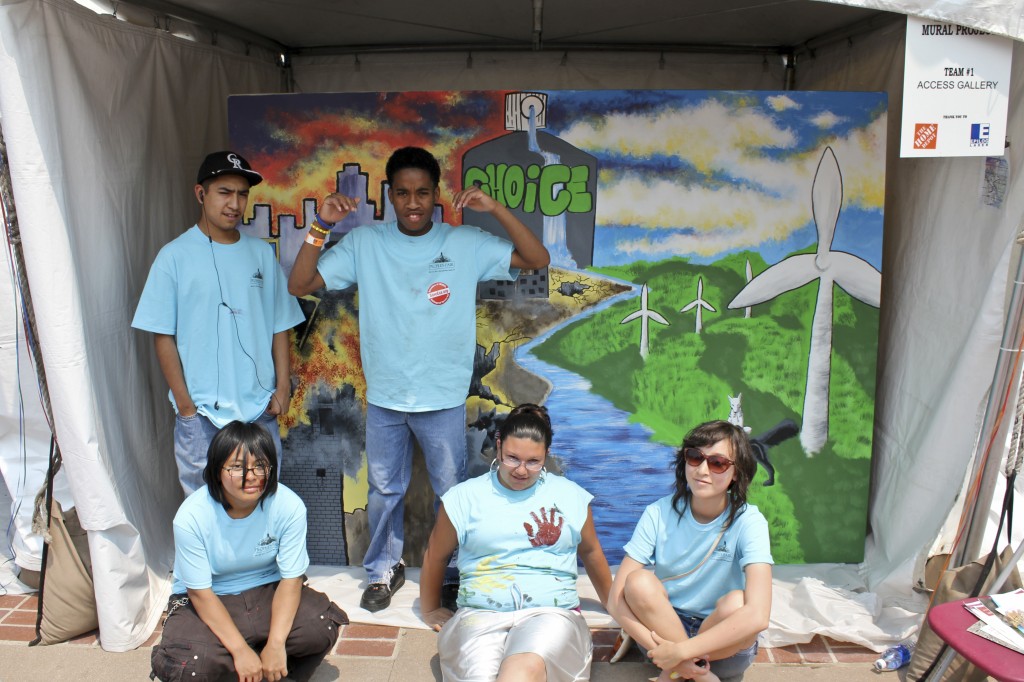
The Access Gallery's mural program aims to open would-be taggers and street artists to the opportunities a future in art has to offer.
Related articles:
- From Graffiti to Fine Art: KAWS at the High
- From the Editor: Art and Vandalism, Under the Bridge
- Gallery: The Graffiti Project on Bokeh
 Graffiti is a common site in the neighborhood around the Access Art Gallery in Denver – not inside, hanging on the walls – but scribbled, pasted or painted on nearly every dumpster and wall for blocks.
Graffiti is a common site in the neighborhood around the Access Art Gallery in Denver – not inside, hanging on the walls – but scribbled, pasted or painted on nearly every dumpster and wall for blocks.
“There’s a lot kids going back and forth through the neighborhood. There was tagging all over the place,” says Damon McLeese, the gallery’s executive director.
Like many places across the country, Denver’s streets show scars of vandalism: Stickers on street signs, scrawls of fat-tipped markers across doorways, and spray paint arching down from seemingly impossible heights.
But where many businesses would have seen an unstoppable scourge of youth defacing private property, McLeese saw an opportunity for a project that would redirect some of the kids’ creative energies and help improve the community.
* * * * * *
Graffiti might be more visible to the average person now than ever before, not because vandals have bombed every wall, but because it has infiltrated popular culture in ways many people could have never imagined in the early 1980s when it first appeared on the walls of art galleries in lower Manhattan.
From those humble roots, contemporary artists such as Banksy and Shepard Fairey, to name just two, have transitioned from petty criminals to icons of the art world (and reaped the financial windfalls of their success as well). The aesthetic influence of decade’s worth of wild style lettering can be seen in advertising, fashion and countless ways throughout popular culture.
There are no national statistics kept about graffiti, but its cost doesn’t go unnoticed by the local governments that must spend millions of dollars annually on clean-up, enforcement and incarcerations tied to the illicit artwork.
For example, during fiscal year 2010-11, Los Angeles “removed 35.4 million square feet of graffiti…an 8.2 percent jump over last year,” according to a New York Times article from July 2011 about the increasing volume of graffiti in cities across the country.
Graffiti might have gained acceptance in the art world, but the perceived increase in vandalism has led to stricter enforcement and increased punishments for taggers in cities across the country, like more stringent curfew laws and prohibiting sales of spray paint to minors.
* * * * * *
The program at Access Gallery doesn’t just hand out paint to kids who aren’t old enough to purchase it in stores.
“Our mission is, we’re working with artists primarily with disabilities,” McLeese explains. “What we’re doing is working with kids in the neighborhood, but they’re being taught by a man with a disability who has street credibility.”
He’s referring to Javier Flores, a well-known graffiti artist in Denver who heads the mural program at the gallery. McLeese attributes much of the program’s success over the past several years to the respect Flores commands from his mentees.
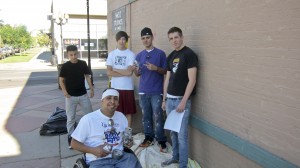
Javier Flores working with Access Gallery youth on a public mural project in Denver, Colo.
“I know what it’s like to be a teenager and getting into trouble for tagging. I definitely went through that phase of my life,” says Flores. “If you delve too deep into that world you’ll get stuck there. I noticed that with a lot of people that I was around. They got stuck being that graffiti guy.”
Flores was drawn to graffiti as a teenager, tagging in the streets of Los Angeles during the mid-to-late-1990s, but while he watched his friends get stuck in the graffiti lifestyle, he wanted more for himself. He was an artist, not a tagger.
After graduating from college, he discovered the Access Gallery and was appreciative that they worked closely with the disabled community.
“I told Damon if he ever had anything he wanted me to volunteer for that I would,” Flores says. Just a few months later, McLeese called to ask whether he’d be interested in a job working with kids in the mural program. Several years later, he’s still involved and appreciates the opportunity to help guide kids past the pitfalls that claimed some of his friends growing up.
* * * * * *
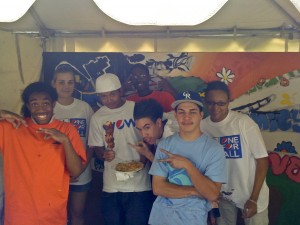
Mural program alum Ratha Sok (third from left) went on to start his on street wear and clothing company, Rawh Creations.
Ratha Sok was one of those neighborhood kids whose tag could be spotted on any number of walls surrounding the Access Gallery back before the mural program ever existed.
“I graduated from West High School, which is right down the street from Access Gallery, so I was always in that neighborhood,” says Sok.
The son of Cambodian refugees who found their way to America after escaping the Khmer Rouge, Sok was drawn to graffiti early in his teens. His friends discovered break dancing, but he was more interested in tagging. Soon thereafter, he started cutting school in order to paint.
He had a unique approach: Sok was trying to write messages that inspired him and his friends. He’d get up on a wall, but he’d also leave behind messages like “Don’t waste your talent,” instead of just his name.
While his content might have been different, he still had to face the harsh truth that his work was illegal. The day after his 16th birthday local police came to his house and gave him a set of handcuffs as a belated gift. They had already gathered evidence from his school and house. It would be sufficient to lock him up on vandalism charges.
However, the experience would turn out to be a positive turning point in Sok’s life; he would soon discover the depths of his entrepreneurial spirit.
“My friend came to my door and asked me to draw his girlfriend’s name for five jolly ranchers,” Sok says, describing the moment when he realized he could leverage his skill and passion for personal gain. “When he did that, it attracted other people, and they saw my talents and started supporting me.”
What began with custom artwork in exchange for candy quickly grew into a desire to start a business.
“I knew that I always wanted to become a streetwear brand, but I didn’t have the resources to do it,” says Sok. “I had to figure out a way to build credibility and funds at the same time.”
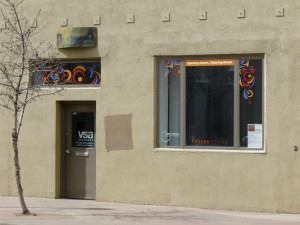
Access Gallery, Denver, Colo.
He started out with some friends, painting custom hats and selling them at events. From there, he expanded into custom t-shirts and other items. Now, having folded his first endeavor, 2Kool, Sok is developing his new brand, Rawh Expressions, with the goal of helping to inspire and empower his community – the same idea that pushed him to paint messages like “Don’t waste your talent,” back in his early days in graffiti.
Since then, Sok has won awards, spoken at a local TEDx event and been written about by local and national media. Now, instead of spending time locked up, he goes back to the juvenile detention center once a year to talk to the kids about how to follow their passion in order to improve their lives.
“I’ve done it for the past three years, and some of the youth are still there,” says Sok. “Over the years, you can see them start to change their mindset. That’s really inspiring.”
* * * * * *
“A lot of these kids never think about turning their creativity into a career,” Damon McLeese, the Access Gallery’s Executive Director explains. “If you think about it, there are a lot of opportunities.”
The mural program at Access Gallery is what McLeese describes as “simple redirection.” The opportunity to learn about graffiti art might entice the youth to join the program, but once they are there, they are exposed to a wide variety of different opportunities.
Through a mix of mentoring, artist residencies and local field trips, the kids in the program have learned about printmaking, photography, architecture and more. Perhaps most importantly, the kids learn that pursuing art can be profitable as well. Money earned by the program from mural commissions or sales of youth-created artwork is divided up among the group.
“The thing that we’re really pushing for these kids is that, yeah, you’re creative and artistic, but if you’re going to tag on buildings, you’re gonna get arrested and really limit your options,” says McLeese. “If we can get you money for your work, isn’t that a lot better than being arrested for your work?”
The kids in the program aren’t all burgeoning young vandals. Each year, the class is comprised of a mix of students, including high school age kids with experience in graffiti and some children with developmental disabilities (often A.D.D. or autism) who are interested in the art, but wouldn’t otherwise have access to learn about it.
According to Flores, graffiti offers a way for the kids to work together on a project and be part of something. It’s a great medium for teaching a range of skill levels too. “It’s so forgiving,” he says. “You can make a mistake and then spray over it. That’s one of the best things I can teach them.”
* * * * * *
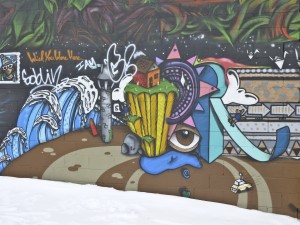
Graffiti tagger "Goldin" defaced a mural near South Broadway in Denver, Colo.
“We still see a lot of scribbles and tags,” McLeese says. “We haven’t seen a decrease in our neighborhood, but across the city there seems to be less.”
Even after five years, the mural program hasn’t stopped graffiti altogether. No one thought it would. The program can only take 10-12 students per year, a small percentage of the total number of kids wandering the streets and tagging.
“You can’t stop graffiti, so it’s a matter of reducing the amount of tagging that happens in a city,” Flores explains. “That’s one thing we help. If they don’t have an outlet, these kids are gonna do what they’re gonna do, and more than likely they’re gonna do tagging.”
While no program could stop graffiti in its tracks, the Access Gallery has begun to improve the opportunities and outcomes available to neighborhood kids who might not have ever discovered how to turn their passion into a profession. In addition to the success of Ratha Sok and Rawh Expressions, McLeese runs down a list of kids who’ve been through the program and are now in college, including some who’ve gone on to study art and design at prominent institutions. He’s also hired several alumni back to help with the summer program.
“We’re working with them on job skills to increase their likelihood of employment down the road using art as the basis,” says McLeese. “We’re still seeing tagging, but there are also a lot more redirection programs.”
After feeling the pride of completing a mural, and learning that their passion can also lead to economic opportunity, many of the kids in the program become as interested in growing up as they are in getting up on walls.
Youth in Access Gallery mural program photo credits: Access Gallery
Graffiti photo credits: Patrick Rodgers/JJIE
Related articles:
- Getting Up: Improving Youth Outcomes with Graffiti in Denver
- From Graffiti to Fine Art: KAWS at the High
- From the Editor: Art and Vandalism, Under the Bridge
- Gallery: The Graffiti Project on Bokeh
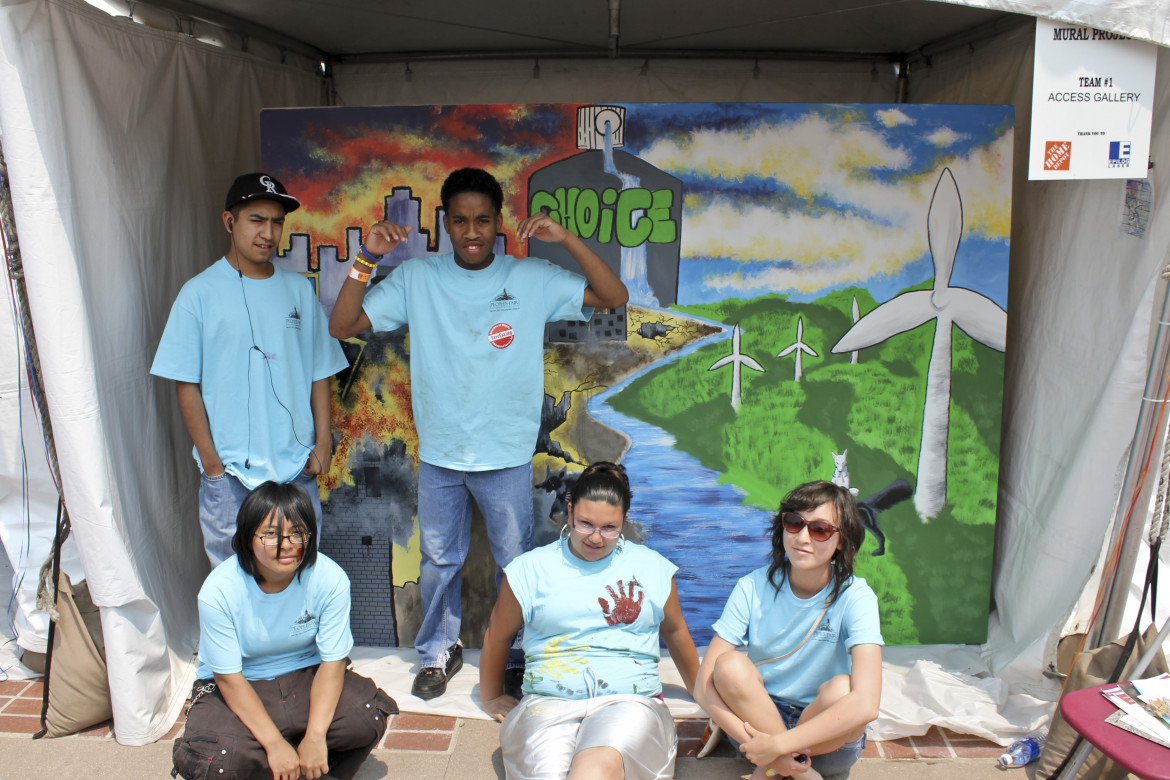
Hey guys! Beautiful work! I would really like to see full pic and I agree with the author. What is a wall mural? Webster says that “there is something, applied or integrated in a wall or ceiling surface. Webster definition is good because it gives a picture of something that we, who becomes part of a wall or ceiling surface. That way he can kind of wall decoration is classified as wall mural. Wall Murals see the different types of murals. different classes covering a range of wall decoration.
Hey guys! Beautiful work! I would really like to see full pic and I agree with the author. What is a wall mural? Webster says that “there is something, applied or integrated in a wall or ceiling surface. Webster definition is good because it gives a picture of something that we, who becomes part of a wall or ceiling surface. That way he can kind of wall decoration is classified as wall mural. Wall Murals see the different types of murals. different classes covering a range of wall decoration.